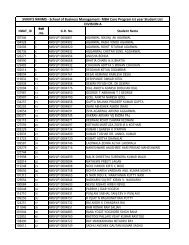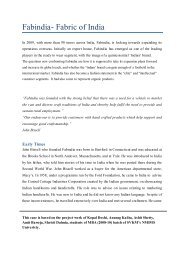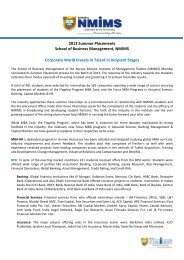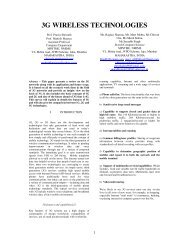Dr.-Ramesh-Narasimhan-Case-study-on-ICT-Adoption - NMIMS
Dr.-Ramesh-Narasimhan-Case-study-on-ICT-Adoption - NMIMS
Dr.-Ramesh-Narasimhan-Case-study-on-ICT-Adoption - NMIMS
You also want an ePaper? Increase the reach of your titles
YUMPU automatically turns print PDFs into web optimized ePapers that Google loves.
36<br />
Nemmadi: bytes and bites of <strong>ICT</strong> implementati<strong>on</strong> M Das Aundhe and R <str<strong>on</strong>g>Narasimhan</str<strong>on</strong>g><br />
why it is pending. If they do not listen, I have to resort to<br />
holding their salary or even issuing a suspensi<strong>on</strong> notice.<br />
In the taluk office, it was often observed that the Comat<br />
Technologies representative operated the computer <strong>on</strong><br />
behalf of the government functi<strong>on</strong>ary, be it the caseworker<br />
to enter data provided by the village accountant or revenue<br />
inspector in the field verificati<strong>on</strong> reports, or the tahsildar<br />
for keying in the final approval. Thus, Comat Technologies<br />
ended up substituting/handholding caseworkers, revenue<br />
inspectors and even the tahsildar in the taluk office for<br />
interfacing with computers. The operati<strong>on</strong> of the computers<br />
in the taluk office was carried out largely by representatives<br />
of Comat Technologies, who moved the login from <strong>on</strong>e<br />
level (revenue inspector) to the next level (caseworker) of<br />
the process, right up to the tahsildar. This was bey<strong>on</strong>d the<br />
call of their duty. Regarding this, Sanjay Chauhan, VP<br />
Comat Technologies said:<br />
This was just a gesture <strong>on</strong> our part to increase adopti<strong>on</strong><br />
of technology, and therefore Nemmadi. However, this<br />
was often not acknowledged and we ended up doing a<br />
thankless job.<br />
Further, a hard copy of all the documents c<strong>on</strong>tinued to be<br />
generated at the taluk office. In fact, the tahsildar was<br />
required to approve by signing off <strong>on</strong> a hard copy of the<br />
caseworker’s note before the Comat Technologies representative<br />
moved the applicati<strong>on</strong> to the tahsildar’s login. The<br />
latter then digitally signed the certificate, which was printed<br />
at the telecentre and handed over to the applicant.<br />
Managing process inefficiencies<br />
During the roll-out of telecentres, the intermediaries at the<br />
taluk level also created hurdles. They were up in arms.<br />
Earlier, at Bhoomi centres, these middlemen filled in the<br />
applicati<strong>on</strong> form, had the whole thing processed and<br />
charged a payment for the same. They were greatly upset<br />
when Nemmadi proposed to have telecentre operators<br />
assist citizens and capture all the citizen informati<strong>on</strong> over<br />
the counter. As per the initial design, it was planned that<br />
a citizen would come almost empty-handed; the applicati<strong>on</strong><br />
form would be generated from the system <strong>on</strong>ce all the<br />
details were keyed in. The photograph, too, would be<br />
captured at the telecentre. The citizen would <strong>on</strong>ly provide<br />
the necessary enclosures, and the telecentre operator would<br />
then send it to the taluk office. However, as the middlemen<br />
refused to allow telecentres to begin operati<strong>on</strong>, government<br />
succumbed to their pressure, and the Nati<strong>on</strong>al Informatics<br />
Centre tweaked the process flow. The middlemen were<br />
allowed to submit the applicati<strong>on</strong> <strong>on</strong> behalf of the citizen,<br />
but they had to get a photograph of the citizen.<br />
The urgency with which the Nemmadi system was<br />
implemented resulted in automating the as-is government<br />
processes without re-engineering them. Therefore, the process<br />
inefficiencies c<strong>on</strong>tinued and resulted in err<strong>on</strong>eous<br />
certificates, delayed resp<strong>on</strong>ses, etc. This manifested the<br />
most during April–June, during which all admissi<strong>on</strong>s to<br />
schools and colleges were scheduled. This period saw the<br />
maximum number of applicati<strong>on</strong>s. There was enormous<br />
pressure <strong>on</strong> end dates due to limited availability of school/<br />
college seats. During this period, citizens did not accept<br />
errors or delays; some of them got middlemen and political<br />
pressure to get their job d<strong>on</strong>e. The impact of any<br />
error during this time was greatly magnified. This, in turn,<br />
eroded the c<strong>on</strong>fidence of citizens in the e-governance<br />
system.<br />
Surmounting technology-related hurdles<br />
The Nemmadi applicati<strong>on</strong> was developed as a real-time<br />
system. However, during the roll-out many power and<br />
c<strong>on</strong>nectivity issues emerged, and the real-time system did<br />
not serve the purpose. Comat Technologies developed the<br />
Global Services Infrastructure that provided for both realtime<br />
and off-line (by writing data into the local queue)<br />
modes of operati<strong>on</strong>. Once c<strong>on</strong>nected, the queue was synchr<strong>on</strong>ized<br />
with the central database at the SDC. This<br />
software development was unforeseen, and c<strong>on</strong>tributed to<br />
the delay in the roll-out of telecentres.<br />
Another major problem Comat Technologies faced was<br />
breaks in c<strong>on</strong>nectivity between telecentre and SDC. Any<br />
break in c<strong>on</strong>nectivity affected the RTC printout. Sanjay<br />
Chauhan narrated that: We had to keep track of all the<br />
stati<strong>on</strong>ery issued by the government. At the end of every<br />
m<strong>on</strong>th, we had to give a report to the government listing out<br />
the RTCs that had been issued, and even those that got<br />
damaged due to communicati<strong>on</strong>s failure had to be reported.<br />
To counter the problem of breaks in prints causing<br />
security or authenticity issues, measures like holograms that<br />
identify the documents’ origin and authenticity were later<br />
introduced.<br />
Post-roll-out phase<br />
M<strong>on</strong>itoring of telecentres<br />
The Karnataka government set up the Nemmadi M<strong>on</strong>itoring<br />
Cell, which received 3% of the share of all B2C and G2C<br />
service charges of the telecentre activities. The Nemmadi<br />
M<strong>on</strong>itoring Cell c<strong>on</strong>sisted of six members, all <strong>on</strong> c<strong>on</strong>tract<br />
from reputed private organizati<strong>on</strong>s – a project manager, a<br />
deputy and three or four testers; the team had no <strong>on</strong>e from<br />
the government. The c<strong>on</strong>tract employees worked full time<br />
with the government and were given salaries in line with the<br />
private sector. The Nemmadi M<strong>on</strong>itoring Cell reported to<br />
the Directorate of Electr<strong>on</strong>ic Delivery of Citizen Services<br />
(DEDCS), and the latter was resp<strong>on</strong>sible for the m<strong>on</strong>itoring<br />
of Nemmadi, am<strong>on</strong>gst other e-governance projects of the<br />
state. If the government or public had any issue with<br />
Nemmadi, the matter was brought to the notice of DEDCS.<br />
For complaints related to employment, training or infrastructure<br />
at particular telecentres, DEDCS called up<strong>on</strong> the<br />
private partner (in this case, Comat Technologies) to sort<br />
the issue out. In additi<strong>on</strong> to regular m<strong>on</strong>itoring, if any<br />
government department wanted to add a service, they<br />
discussed it with DEDCS. For example, if the Department of<br />
Agriculture wanted to make commodity prices available as<br />
a service in the telecentre, they would have to route the<br />
discussi<strong>on</strong> through DEDCS. Based <strong>on</strong> the requirement, if<br />
some software needed to be developed DEDCS got it<br />
developed either by the Nati<strong>on</strong>al Informatics Centre or by<br />
some other private IT organizati<strong>on</strong>.<br />
Collecti<strong>on</strong>s from Nemmadi were also handled by DEDCS.<br />
As per the agreement, whatever proceeds the telecentre










